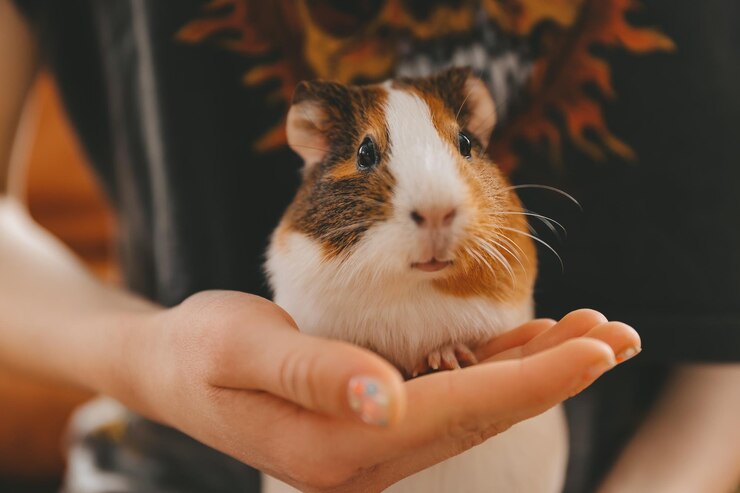Guinea pigs are adorable, low-maintenance pets, but keeping their cage clean and comfortable plays a crucial role in their well-being. Choosing the right cage liner is essential for preventing odor, promoting foot health, and ensuring overall hygiene.
This blog delves into the world of guinea pig bedding, guiding you through the different options and helping you pick the perfect liner for your furry friends.
Understanding the Importance of Cage Liners

Traditional bedding options like wood shavings or paper pellets have been widely used, but concerns about dust, allergens, and potential health risks have led to the rise of alternative solutions. Here’s why choosing the right cage liner matters:
- Foot health: Guinea pigs have sensitive feet, and prolonged exposure to damp or abrasive bedding can lead to pododermatitis (bumblefoot). Good liners wick away moisture, keeping their feet dry and comfortable.
- Odor control: No one enjoys a stinky cage! Effective liners absorb urine and prevent ammonia build-up, keeping your home and your piggies’ environment fresh.
- Hygiene and health: A clean cage reduces the risk of bacterial infections and respiratory problems. Selecting the right liner promotes good hygiene and supports overall health.
- Sustainability: Some disposable bedding options create significant waste. Reusable liners are eco-friendly and cost-effective in the long run.
Exploring the Different Types of Liners

Before diving into specifics, let’s explore the main types of guinea pig cage liners:
1. Absorbent Bedding:
- Wood shavings: Aspen and kiln-dried pine are popular choices, but dust concerns remain. Opt for dust-free alternatives if possible.
- Paper-based bedding: Made from recycled paper or wood pulp, these are dust-free and absorbent, but may not be as effective in odor control.
- Hemp bedding: Highly absorbent and dust-free, hemp offers excellent odor control and is eco-friendly. However, it can be expensive and challenging to find.
2. Fleece Liners:
- DIY fleece liners: Cost-effective and customizable, but require sewing skills and frequent washing. Choose high-quality fleece with an absorbent layer underneath.
- Pre-made fleece liners: Available in various sizes and styles, these offer convenience but can be pricier. Ensure they have a waterproof layer and a separate absorbent layer.
3. Other Options:
- Chlorine-free fleece: Gentler on sensitive skin and more eco-friendly than traditional fleece.
- Bamboo liners: Highly absorbent and naturally odor-resistant, but can be expensive.
- Carefresh Natural: Made from recycled paper pulp, dust-free, and absorbent, but not as effective for odor control as other options.
Factors to Consider When Choosing a Liner

Now that you know the options, here are key factors to consider when making your decision:
- Number of guinea pigs: More piggies means more waste! Choose a liner size and absorbency level that can handle the volume.
- Cage size: Ensure the liner covers the entire floor area for maximum comfort and hygiene.
- Piggy preferences: Some guinea pigs love digging, while others prefer a smooth surface. Choose a liner that caters to their individual needs.
- Ease of cleaning: Consider how much time and effort you can devote to cleaning. Disposable options offer convenience, while reusable liners require washing but are more budget-friendly in the long run.
- Cost: Weigh the initial cost of the liner against its durability and lifespan. Factor in cleaning supplies and potential replacements when making your decision.
Tips for Using and Maintaining Cage Liners
Once you’ve chosen the perfect liner, follow these tips for optimal results:
- Spot clean daily: Remove waste and soiled areas daily to prevent odors and keep the liner hygienic.
- Deep clean regularly: Depending on the liner type, wash or replace it completely every 1-2 weeks.
- Use absorbent pads: Place absorbent pads under hay feeders and litter boxes for extra protection and easier cleaning.
- Monitor your guinea pigs: Observe their behavior and foot health to ensure the chosen liner is working well.
- Air dry liners: Whenever possible, air dry fleece liners instead of using a dryer to extend their lifespan.
Conclusion
Choosing the right cage liner for your guinea pigs is a personal decision based on your needs and preferences. By understanding the different options, considering key factors, and following proper cleaning practices, you can create a comfortable and healthy environment for your furry companions. Remember, happy piggies start with a clean and cozy cage, and the right liner plays a crucial role in achieving that goal.
Bonus Tip: Research reputable brands and online communities for guinea pig owners to get recommendations and additional insights on choosing

